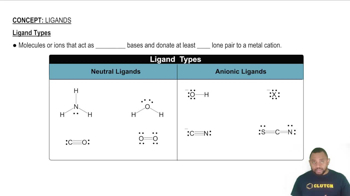What is the systematic name for each of the following coordination compounds?
(a) Cs[FeCl4]
(b) [V(H2O)6](NO3)3
 Verified step by step guidance
Verified step by step guidance



What is the systematic name for each of the following coordination compounds?
(a) Cs[FeCl4]
(b) [V(H2O)6](NO3)3
Constitutional isomers of a ruthenium(II) coordination compound are shown below.
(a) Give the formula and name for structures 1-3.
(b) Which structures are linkage isomers?
(c) Which structures are ionization isomers?
Six isomers for a square planar palladium(II) complex that contains two Cl-and two SCN-ligands are shown below.
(a) Which structures are cis-trans isomers?
(b) Which structures are linkage isomers?
Tell how many diastereoisomers are possible for each of the following complexes, and draw their structures.
(a) Pt(NH3)3Cl (square planar)
(b) [FeBr2Cl2(en)]-
Tell how many diastereoisomers are possible for each of the following complexes, and draw their structures.
(c) [Cu(H2O)4Cl2]+
(d) Ru(NH3)3I3
Which of the following complexes can exist as enantiomers? Draw their structures.
(a) [Cr(en)3]3+
(b) cis-[Co(NH3)Cl]2+
(c) trans-[Co(en)2(NH3)Cl]2+
(d) [Pt(NH3)3Cl3]+